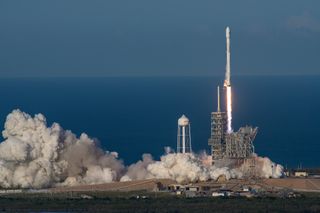Used SpaceX Rocket Launches Satellite, Then Lands in Historic 1st Reflight
CAPE CANAVERAL, Fla. — A SpaceX Falcon 9 rocket soared off a seaside launch pad at NASA's Kennedy Space Center here today (March 30) on an unprecedented second mission to deliver a spacecraft into orbit, proving the booster's reusability.
The two-stage, 23-story-tall rocket lifted off at 6:27 p.m. EDT (2227 GMT) in the second launch in two weeks for Elon Musk's SpaceX, which is ramping up its flight rate following an accident in September.
Perched on top of the rocket, which sported a new upper stage and payload fairing, was the 11,645-lb. (5,282 kilograms) SES-10 communications satellite, which is intended to provide TV, internet and other services to customers in Latin America. [In Photos: SpaceX Launches, Lands 1st Reused Falcon 9 Rocket]
"This is a really, really exciting step forward," Martin Halliwell, chief technology officer of Luxembourg-based SES, said before launch. "I think the whole industry is looking."

The rocket's first stage previously lifted off in April 2016, sending SpaceX's robotic Dragon cargo ship on its way to the International Space Station for NASA. The booster then landed on one of SpaceX's robotic "drone ships" in the ocean and was refurbished for reflight, a key component of Musk's goal to cut launch costs.
The Falcon 9 first stage aced its landing again tonight, settling softly onto the deck of the drone ship "Of Course I Still Love You."
"It’s an amazing day for … the space industry," Musk said shortly after the rocket touched down. "It means you can fly and refly an orbit-class booster, which is the most expensive part of the rocket. This is going to be ultimately a huge revolution in spaceflight."
Get the Space.com Newsletter
Breaking space news, the latest updates on rocket launches, skywatching events and more!
SpaceX also successfully recovered the Falcon 9's payload fairing — the nose cone that protected SES-10 during liftoff — Musk revealed during a post-launch teleconference with reporters. The $6 million fairing achieved its own soft landing in the Atlantic Ocean using an onboard thruster system and a parachute, Musk said.
"That was definitely the cherry on the cake," he said, adding that SpaceX intends to re-fly payload fairings just as it does Falcon 9 first stages.
SpaceX has now launched and landed Falcon 9 first stages nine different times. Six of these touchdowns have occurred on drone ships, and three have taken place on terra firma at Cape Canaveral. (SpaceX would ideally like to bring all its boosters back on land, Musk has said, but some missions use so much fuel on the ascent phase that ocean touchdowns are necessary.)
Today's launch continues what is expected to be a busy year for both SpaceX, which is aiming to fly about every two to three weeks, and for SES, which has nine more satellites awaiting rides into orbit. Three of those trips will employ Falcon 9 rockets, and the company is open to using previously flown boosters again, Halliwell said.
SES-10 was to be delivered into an initial elliptical orbit ranging from 135 miles (218 kilometers) to 22,002 miles (35,410 km) above the planet and inclined about 26.2 degrees relative to the equator.
Over the next month or so, the satellite will maneuver itself until it reaches its intended operational circular orbit some 22,300 miles (35,800 km) above the equator and in a relatively fixed position at 67 degrees west longitude, SES representatives have said.
Today's launch was SpaceX's third from Kennedy Space Center's Launch Complex 39A, which hosted most of the Apollo moon mission and space shuttle liftoffs. In 2014, SpaceX signed a 20-year lease to use the pad.
SpaceX is not the first company to launch a booster to space multiple times. Blue Origin, which is run by Amazon.com founder Jeff Bezos, launched and landed the same New Shepard rocket five times between November 2015 and October 2016. But all of those New Shepard missions were test flights to suborbital, not orbital, space.
Editor's note: This story was updated at 9:20 p.m. EDT to add that SpaceX recovered the payload fairing during today's launch as well.
Follow us @Spacedotcom, Facebook or Google+. Originally published on Space.com.
Join our Space Forums to keep talking space on the latest missions, night sky and more! And if you have a news tip, correction or comment, let us know at: community@space.com.

Irene Klotz is a founding member and long-time contributor to Space.com. She concurrently spent 25 years as a wire service reporter and freelance writer, specializing in space exploration, planetary science, astronomy and the search for life beyond Earth. A graduate of Northwestern University, Irene currently serves as Space Editor for Aviation Week & Space Technology.